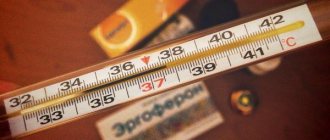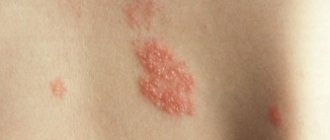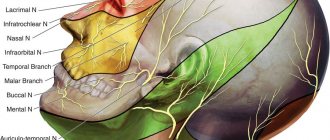- Acupuncture Quickly relieves inflammation and pain, has an anti-edematous and anti-ischemic effect. The introduction of hair-thin needles reliably eliminates pain attacks.
- Pharmacopuncture Used in combination with acupuncture. This procedure involves the introduction of microdoses of homeopathic medicines, which help achieve the fastest possible analgesic and anti-inflammatory effect.
- Acupressure Improves local blood circulation, eliminates spasms of facial muscles, relieves emotional and muscle tension, improves metabolic processes.
- Moxotherapy on bioactive points of the body has a general strengthening effect, improves immunity, and activates the body's protective and regenerative processes.
- Herbal medicine Ideally complements the effects of procedures and consolidates their results, has a sedative effect, improves blood supply to nerve tissue.
Trigeminal neuralgia in Eastern medicine
With regard to trigeminal neuralgia, as with all other diseases, oriental medicine takes a comprehensive approach.
If Western medicine does not go beyond the immediate causes of nerve damage - compression by edema, hypothermia, viral infection, unsuccessful dental treatment or other obvious factors, then Eastern medicine finds and eliminates the root cause of the disease.
Trigeminal neuralgia, like all neuralgia and neuritis, refers to disorders of the Rlung (Wind) regulatory system. This system is responsible for mental activity, psycho-emotional state and nervous regulation of the body. The main reasons why Wind diseases occur are stress, negative emotions, hypothermia, lack of nutrition, sleep, and overwork. It would seem, what is the connection between the trigeminal nerve and the emotional state? However, it exists, and medical science confirms it.
According to official statistics, in 20% of cases, trigeminal neuralgia occurs against a background of negative emotions. In reality, this percentage is much higher if we take into account the long-term consequences of nervous stress, mental trauma, and emotional overload.
Neuralgia is often accompanied by depression and neuroses. Combined with strong cold winds and hypothermia of the face, this is likely to produce symptoms of trigeminal neuralgia.
The question arises: is it enough to simply relieve pain, reduce swelling of soft tissues, and restore normal blood supply to the nerve in order to consider the problem solved? Or does the treatment of trigeminal neuralgia require the same comprehensive approach as the treatment of nervous disorders? Eastern medicine answers this question unequivocally: without restoring the balance of the body, treatment of trigeminal neuralgia cannot be truly effective, successful, and its results cannot be long-lasting and lasting. Only by eliminating all the causes of the disease can the problem of neuralgia be solved so that the patient forgets about it for a long time or forever.
That is why treatment of trigeminal neuralgia at the ITVM clinic includes not only the use of medical procedures - acupuncture, acupressure and others, but also a course of herbal medicine. Tibetan herbal remedies used for neuralgia normalize the psycho-emotional state, increase resistance to stress, improve sleep, help overcome depression, neurosis and have a general strengthening effect. In addition, “ITVM” performs acupuncture on the bioactive points of the body’s meridians in order to restore normal circulation of vital energy and thereby eliminate its overexpenditure, which leads to exhaustion of the nervous system.
Compresses
The simplest heating is done using a hard-boiled chicken egg. A hot egg is pressed against the area of inflammation or rolled along the nerve. This procedure can be used only after acute inflammation has resolved. At the stage of acute nerve inflammation, any heating is excluded.
Heat a handful of buckwheat in a dry frying pan, pour into a linen bag and apply to the affected area of the face. As a hot compress, along with buckwheat, you can use salt or flax seeds, which need to be steamed over boiling water.
Hot mud applications (Taman, Tambukan mud) help with neuralgia. To do this, a soft hot cake is made from mud, which is applied to the sore spot. You can add a small amount of vinegar to the healing mud.
Infuse four teaspoons of crushed (dried) marshmallow roots in a glass of water for several hours. Soak gauze folded in several layers with this infusion. Apply to the affected area of the face.
Atypical symptoms of trigeminal neuralgia
Trigeminal neuralgia usually manifests itself as an acute attack of pain affecting the right or left (less often) half of the face.
There are also atypical signs of this disease. In particular, trigeminal neuralgia can manifest as pain in the base of the tongue, throat, ear, or sore throat from cold or sour foods. This is the so-called pharyngeal form of trigeminal neuralgia.
If the cause of neuralgia is a herpes virus infection, the symptoms may also be atypical - headache and itching, the appearance of white areas on the skin. The pain may not be paroxysmal, but constant, moderate in nature. In general, any form of the disease in which pain does not occur in attacks, but is constant (pulsating, aching) and accompanied by a burning sensation, is called trigeminal neuralgia type 2, or atypical neuralgia.
When diagnosing the disease, trigeminal neuralgia should be differentiated from symptoms of multiple sclerosis.
With multiple sclerosis, short-term painful attacks covering half the face are also possible, but other symptoms are also present - severe sweating of the forehead, lacrimation, tremors (shaking hands), unilateral blurred vision, dizziness, poor coordination of movements and a number of other neurological symptoms.
When your face hurts. What is trigeminal neuralgia?
Attacks of trigeminal neuralgia can be so painful that some compare them to torture. But the body itself becomes a torture device. Is it possible to be saved? Marina Borisovna Slonova, a neurologist at the Expert Clinic Vladikavkaz, spoke about the occurrence of the disease, diagnosis and treatment methods for this pathology.
— Marina Borisovna, what is trigeminal neuralgia?
- This is a chronic pathology of the trigeminal nerve - the largest of the twelve pairs of cranial nerves. The trigeminal nerve has three branches. Most often, the lesion is localized in the lower part of the face.
— What are the causes of trigeminal neuralgia?
— There are classical and symptomatic forms of the disease. In classic trigeminal neuralgia, the lesion is provoked by a vasoneural conflict - compression (squeezing) of the nerve by a blood vessel. This may occur due to the abnormal structure of blood vessels or the appearance of tumors or cysts that push the vessel towards the trigeminal nerve.
Symptomatic neuralgia becomes a consequence of other diseases affecting the trigeminal nerve. It can be post-traumatic (for example, sometimes trigeminal neuralgia appears after tooth extraction). Also, tumors (for example, neuroma), tunnel compression, multiple sclerosis, and viral diseases often lead to the disease. Trigeminal neuralgia can also appear due to tumor or inflammatory processes in the submandibular lymph nodes.
— What are the symptoms of trigeminal neuralgia?
— Based on the nature of the disease, the disease is divided into two types: typical (type 1) and atypical (type 2). The first type is characterized by attacks of sharp pain in the area of innervation of the affected branch of the trigeminal nerve (most often this is the second or third branch). The duration of such attacks is from several seconds to two minutes. An attack can be triggered by exposure to triggers: cold, touch, etc.
The second type is manifested by constant pain of less intensity in the same area.
— Could such symptoms be characteristic of another disease, with what should trigeminal neuralgia be differentiated?
- Yes, similar pains can occur in other cases. They should be differentiated from diseases of the ENT organs, dysfunction of the temporomandibular joint, and dental pathologies.
— How is trigeminal neuralgia diagnosed?
— For symptoms of trigeminal neuralgia, the doctor refers the patient to a CT and MRI (standard or 3D) of the brain and head tissues. MRI allows you to diagnose the demyelinating process (multiple sclerosis) and exclude brain pathologies. The CT scan clearly shows the bone structure. Contrast angiography is required to detect vascular compression. Helical CT may be needed.
Read materials on the topic:
When is CT indispensable? MRI for a sore head
— Which doctor treats trigeminal neuralgia?
— First of all, this is the task of a neurologist. But since various factors lead to trigeminal neuralgia, collaboration with dentists, otolaryngologists, and sometimes the help of a neurosurgeon may be required.
— What treatment methods for trigeminal neuralgia are used in modern medicine?
- First, conservative treatment is used: medications and physical therapy. This is enough in 90% of cases. The basis of therapy is antiepileptic drugs. The first line drug of choice is carbamazepine. If it is not effective enough or produces side effects, it is replaced with second-line drugs of choice. The doctor must carefully monitor the patient's condition and be prepared to change prescriptions if side effects occur. Additionally, muscle relaxants and antidepressants can be used. Among the effective physiotherapeutic agents are Sollux, UV rays, and a heating pad.
If conservative therapy does not bring the desired effect, microsurgery is resorted to. In case of vasoneural conflict, vascular decompression is performed, during which the pressure of the vessel on the branch of the trigeminal nerve is eliminated. In other cases, radiosurgery on the ganglia is possible.
— Is treating trigeminal neuralgia dangerous with folk remedies?
- I would say yes. Without knowing exactly what method we are talking about, it is difficult to say what the degree of harm may be. But in any case, it is impossible to cure trigeminal neuralgia without modern medications. By preferring traditional methods, a person deprives himself of the opportunity to receive timely help, and his condition worsens. In addition, trigeminal neuralgia can accompany very dangerous diseases (for example, neuroma). But proper treatment is not carried out because the person does not see a doctor.
Interviewed by Daria Ushkova
You can make an appointment with a neurologist here. ATTENTION: the service is not available in all cities
The editors recommend:
What is neurovascular conflict? Dorsopathy: what is it and how to treat it? Chest pain: is it the heart or the nerves?
For reference:
Slonova Marina Borisovna
Neurologist.
Accepts at the “Clinic Expert” Vladikavkaz at Barbashova Street, 64. Make an appointment by phone 8-8672-33-39-33
Treatment of trigeminal neuralgia at home
To relieve pain from trigeminal neuralgia, traditional medicine uses warming - compresses of hot salt or heated buckwheat, a hot hard-boiled egg. Such products must be used with great caution, since exposure to heat can aggravate the inflammatory process. There is also an opposite folk method of treatment - “freezing” the affected area with a piece of ice.
Another folk remedy is fir oil, which is rubbed into the affected half of the face and has a warming effect. In the same way, lavender oil, star balm, garlic oil, radish juice, alcohol tincture of propolis, grated horseradish, tincture of birch buds with vodka and other external remedies are used.
To relieve the symptoms of trigeminal neuralgia, folk medicine uses herbal preparations with calming, sedative and anticonvulsant effects from mint, chamomile, thyme, yarrow and other medicinal herbs.
It should be emphasized that with all the variety of traditional medicine recipes, they only help relieve pain, but are not a means of treating trigeminal neuralgia. They can be used to tide you over for a while before a visit to the doctor, but not as a substitute for such a visit.
Trigeminal nerve, causes of inflammation and treatment methods
At moments of exacerbation, attacks last from 15 seconds to two minutes and are sometimes so strong that people are ready to use the most radical measures just to alleviate their condition. Most often, women over 40 years of age are affected by the disease. Prerequisites for the development of the disease may include problems with blood vessels, endocrinology and allergies of varying severity.
The most common causes of inflammation of the trigeminal nerve
Most often, the disease develops as a consequence of:
- Poorly administered anesthesia during dental surgery.
- Head injuries.
- Diseases of the facial part of the head.
- Tumors in the facial area.
- Herpes virus.
Traditional methods of therapy
Classical medicine approaches the treatment of the disease very conservatively, so drug treatment, physical therapy, and surgery are usually prescribed.
Alternative traditional medicine in the treatment of inflammation of the trigeminal nerve
- Herbal infusions.
- For 200 gr. mint you need to take 100 grams. St. John's wort and 100 gr. valerian, all herbs are crushed and mixed. Then place 2 tbsp in 0.5 liters of water. tablespoons of the mixture, bring to a boil and simmer over medium heat for 15 minutes. The resulting product is infused in a dark, cool place for about 5 hours. You need to take it three times a day, 1 tablespoon.
- Take 150 gr. chamomile and 150 gr. burdock (all in dry form), place in half a liter of water, put on fire and after boiling, boil for another 20 minutes. Strain and let it brew for 24 hours. Drink after meals 2 hours later.
- Take aloe juice, the plant must be at least three years old, and take it three times a day, 1 teaspoon before meals.
- Birch sap is endowed with unique properties. It has a special composition and properties that can significantly alleviate the patient’s condition, relieve inflammation and reduce the intensity of pain. How to use birch sap during treatment? Drink at least 5 glasses throughout the day, wash your face with it twice a day.
Surprisingly, sometimes the most basic and common things can help in pain relief and treatment.
- Ointments, rubs, lotions, compresses
- Such a common houseplant as geranium helps greatly with neuralgia of the facial nerves. For treatment, you need to pick a few leaves, secure them on your face with a bandage and leave for a couple of hours. Leaves can be changed periodically.
- Black radish and lavender will also help get rid of pain; to do this, you need to mix their juice in a ratio of 20 (radish) to 1 (lavender oil). Rub the mixture thoroughly in the direction of the nerve and cover with a warm cloth to achieve the greatest effect.
- Marshmallow, or more precisely, its root, can also be effective. They are thoroughly crushed and poured with boiling water. The resulting mixture should be allowed to brew for 1 day. A clean piece of cloth is moistened in the solution and applied to the sore spot, covered with a soft warm cloth on top and kept for at least an hour.
Ointments, lotions, rubbing and compresses usually have the most significant effect in treating inflammation.
- Phytoprinses
It is extremely necessary to rinse the mouth during inflammation of the trigeminal nerve. Naturally, rinses should be herbal based.
For example, chamomile. This can be self-collected or purchased at a pharmacy. You need to take 1 teaspoon of the herb, pour 200 ml of boiling water, leave, let the sediment settle to the bottom, cool, strain and you can start the rinsing procedure. Rinse at least 5 times a day for 1-15 minutes.
Preventive measures to prevent the occurrence and development of the disease
In order to prevent trigeminal neuralgia, it is necessary to take preventive measures, which include:
- Track your oral health.
- Avoiding head injuries
- Taking care of your immune system.
Author: K.M.N., Academician of the Russian Academy of Medical Sciences M.A. Bobyr
Prevention of trigeminal neuralgia
Strengthening the immune system is often recommended as a means of preventing trigeminal neuralgia. However, this advice is too general, and in general is not very suitable for this neuralgia, which is almost never directly associated with reduced immunity. Of course, there is nothing wrong with strengthening your immune system, but your main focus should be elsewhere. From the point of view of Eastern medicine, trigeminal neuralgia is a disease of the Wind.
For the prevention of such diseases, the main importance is the quality of sleep, proper work and rest schedule, good nutrition, avoidance of stress and overwork.
This means that the diet must be complete, contain a sufficient amount of vitamins B, C, A, D and E, fats (including not only vegetable, but also animal fats, for example, butter, and even better, ghee). It is necessary to get enough rest, get enough sleep, monitor your mood, avoid negative emotions and depression. And of course, you need to avoid cold winds and drafts.
For symptoms of neurosis and other nervous disorders, you should undergo a preventive course of herbal medicine. If there are serious signs of a nervous system disorder, it is better to immediately undergo a full treatment course of acupuncture, massage, herbal remedies and other methods of oriental medicine. This will help avoid not only trigeminal neuralgia, but also other neurogenic pain syndromes.
Rubbing
Essential oils are used to rub into painful areas of the face. Garlic, radish juice, honey have a warming effect and are useful for Wind disorders, therefore they are also recommended for local rubbing.
- Fir oil should be used in a mixture with vegetable or ghee in a ratio of one to five. Gently rub into painful spots with your fingertips. Lavender oil is used in the same way.
- Garlic oil is mixed with vodka - one drop per glass (50 ml). Rubbed into sore areas. Almond oil is used in the same way.
- You can also rub black radish juice, honey dissolved in water or a 10% mummy solution into painful points.
- You can use 20% propolis tincture in alcohol for rubbing, mixed in equal parts with vegetable oil.
- A good warming remedy in Tibetan medicine for neuralgia is a mixture of ghee, garlic, and hot red pepper. This mixture should be gently rubbed onto the affected area of the face, especially trigger points. This mixture is recommended in the treatise “Zhud-Shi” as a medicine against Wind disorders for internal or external use.
- Cut a clove of garlic in half and wipe the cut on painful areas of the face.
- For rubbing, you can use pure fir oil, moistening a cotton pad or cotton pad with a small amount.










